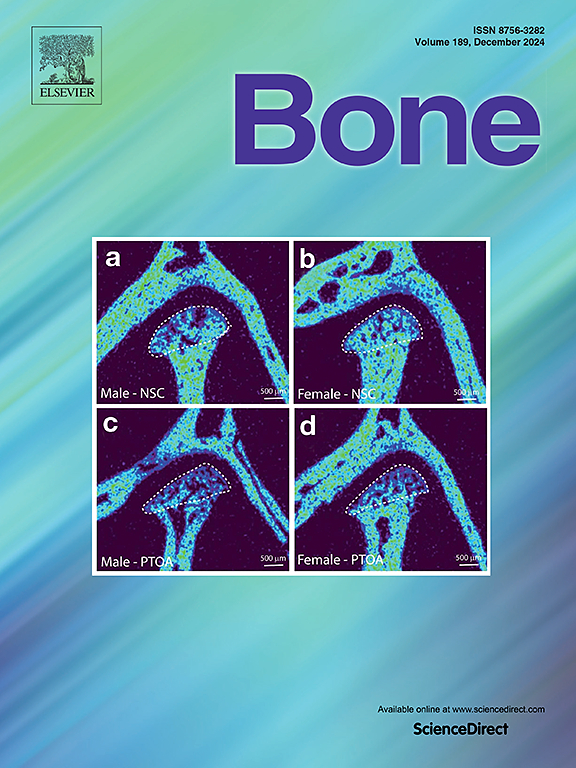成人2型糖尿病患者血清碳酸氢盐浓度与骨密度相关:非裔美国人糖尿病心脏研究
IF 3.6
2区 医学
Q2 ENDOCRINOLOGY & METABOLISM
引用次数: 0
摘要
背景:骨质疏松症是老年人发病和死亡的重要原因。2型糖尿病(T2D)患者通常骨密度较高,但骨折发生率也较高。与此同时,与欧洲裔美国人相比,黑人患骨质疏松症的几率较低。血清碳酸氢盐可能是骨质流失的危险因素,但研究是相互矛盾的,并且对T2D或黑人的这种关系知之甚少。方法:在非裔美国人糖尿病心脏研究(AA-DHS)中,我们检测了300名T2D患者血清碳酸氢盐与骨密度变化之间的纵向关系。基线时测量血清碳酸氢盐,基线时和随访5年后使用CT胸椎和腰椎体积骨密度(vBMD)扫描评估骨密度。多变量线性回归模型评估了基线血清碳酸氢盐与vBMD纵向变化之间的关系,并对多个混杂因素进行了调整。结果该队列50%为女性,平均年龄55.1岁,T2D病程10.2岁。平均基线血清碳酸氢盐为26.6 (SD 3.3) mEq/L;腰椎中位基线vBMD为179.3 (IQR为148.2,208.9)mg/cm3,胸椎中位基线vBMD为204.9 (IQR为171.6,231.9)mg/cm3。在完全调整分析中,基线血清碳酸氢盐每增加1 mEq/L与腰椎vBMD的5年相对增加显著相关(0.94 mg/cm3, p <;0.001)和胸椎vBMD (1.35 mg/cm3, p <;0.001),没有明显的阈值效应或性别差异。结论:在这组黑人T2D患者中,随着时间的推移,较高的基线血清碳酸氢盐水平与骨密度的改善有关。需要进一步的研究来确定补充碱是否会改善这一人群的骨密度损失。本文章由计算机程序翻译,如有差异,请以英文原文为准。
Serum bicarbonate concentration is associated with bone density in adults with type 2 diabetes mellitus: African American-Diabetes Heart Study
Background
Osteoporosis is a significant cause of morbidity and mortality in the aging population. Individuals with type 2 diabetes mellitus (T2D) typically have higher bone density yet also a higher rate of fractures. Blacks, meanwhile, have a lower incidence of osteoporosis compared to European Americans. Serum bicarbonate may be a risk factor for bone loss, but studies are conflicting, and little is known about this relationship in T2D or Blacks.
Methods
We examined the longitudinal relationship between serum bicarbonate and change in bone density in 300 participants with T2D in the African American-Diabetes Heart Study (AA-DHS). Serum bicarbonate was measured at baseline, and bone density was assessed using CT volumetric bone mineral density (vBMD) scans of the thoracic and lumbar vertebrae at baseline and after five years of follow-up. Multivariate linear regression models assessed associations between baseline serum bicarbonate and longitudinal change in vBMD, adjusted for multiple confounders.
Results
The cohort was 50 % female, with mean age and T2D duration 55.1 years and 10.2 years, respectively. The mean baseline serum bicarbonate was 26.6 (SD 3.3) mEq/L; median baseline lumbar spine vBMD 179.3 (IQR 148.2, 208.9) mg/cm3, and median baseline thoracic spine vBMD 204.9 (IQR 171.6, 231.9) mg/cm3. In fully-adjusted analyses, each 1 mEq/L increase in baseline serum bicarbonate was significantly associated with 5-year relative increase in lumbar vBMD (0.94 mg/cm3, p < 0.001) and thoracic vBMD (1.35 mg/cm3, p < 0.001), without a clear threshold effect or differences by sex.
Conclusions
In this cohort of Blacks with T2D, higher baseline serum bicarbonate levels were associated with improved changes in bone density over time. Further studies are needed to determine if alkali supplementation would ameliorate loss of bone density in this population.
求助全文
通过发布文献求助,成功后即可免费获取论文全文。
去求助
来源期刊

Bone
医学-内分泌学与代谢
CiteScore
8.90
自引率
4.90%
发文量
264
审稿时长
30 days
期刊介绍:
BONE is an interdisciplinary forum for the rapid publication of original articles and reviews on basic, translational, and clinical aspects of bone and mineral metabolism. The Journal also encourages submissions related to interactions of bone with other organ systems, including cartilage, endocrine, muscle, fat, neural, vascular, gastrointestinal, hematopoietic, and immune systems. Particular attention is placed on the application of experimental studies to clinical practice.
 求助内容:
求助内容: 应助结果提醒方式:
应助结果提醒方式:


